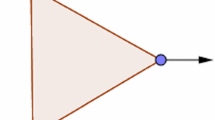Abstract
Consider the spatial Newtonian three-body problem at fixed negative energy and fixed angular momentum. The moment of inertia I provides a measure of the overall size of a three-body system. We will prove that there is a positive number \(I_0\) depending on the energy and angular momentum levels as well as the masses such that every solution at these levels passes through \(I\le I_0\) at some instant of time. Motivation for this result comes from trying to prove the impossibility of realizing a certain syzygy sequence in the zero angular momentum problem.




Similar content being viewed by others
References
Albouy, A.: Lectures on the two-body problem. In: Cabral, H., Diacu, F. (eds.) Recife Lectures on Classical and Celestial Mechanics. Princeton University Press, Princeton (2002)
Birkhoff, G.D.: Dynamical Systems. American Mathematical Society Colloquium Publications, vol. IX, (1927)
Chenciner, A., Montgomery, R.: A remarkable periodic solution of the 3-body problem in the case of equal masses. Annal Math. 152(3), 881–901 (2000)
Féjoz, J.: Quasiperiodic motions in the planar three-body problem. J. Differ. Equ. 183, 159–195 (2002)
Hadamard, J.: Sur un Mémoire de M. Sundman. Bull. Sci. Math. 39, 249–264 (1915)
Kaplan, S., Levi, M., Montgomery, R.: Making the Moon reverse it’s orbit, or, stuttering in the planar three-body problem. Discrete Contin. Dyn. Syst. Ser. B 10, 569–595 (2008)
Laskar, J., Marchal, C.: Triple close approach in the three-body problem: a limit for bounded orbits. Celestial Mech. 32, 15–28 (1984)
Marchal, C.: Sufficient conditions for hyperbolic-elliptic escape and for ‘ejection without escape’ in the three-body problem. Celest. Mech. 9(3), 381–393 (1974)
Marchal, C.: The Three body problem. Elsevier Stud. Astronaut. 4, 301–519 (1990)
Marchal, C., Yoshida, J.: A test of escape valid for very small mutual distances I. The acceleration and the escape velocities of the third body. Celest. Mech. 33, 193–207 (1984)
Meyer, K.: Comet-like periodic orbits in the N-body problem. J. Comput. Appl. Math. 52, 337–351 (1994)
Moeckel, R.: Some Qualitative Features of the Three-Body Problem, Contemporary Mathematics, vol. 81. Hamiltonian Dynamics (1988)
Moeckel, R., Montgomery, R.: Realizing all reduced syzygy sequences in the planar three-body problem. Nonlinearity 28, 1919–1935 (2015)
Montgomery, R.: Infinitely many syzygies. Arch. Ration. Mech. Anal. 164, 311–340 (2002)
Montgomery, R.: The zero angular momentum, three-body problem: all but one solution has syzygies. Ergodic Theory. Dyn. Syst. 27, 1933–1946 (2007)
Montgomery, R.: The three-body problem and the shape sphere. Am. Math. Monthly 122(4), 299–321 (2015)
Pollard, H.: Celestial Mechanics. Prentice Hall, Englewood Cliffs, NJ (1966)
Pollard, H.: Disintegration and Escape, Periodic Orbits, Stability and Resonances, pp. 53–55 (1970)
Sundman, K.: Mémoire sur le Problème des trois corps. Acta Math. 36, 105–179 (1912)
Acknowledgements
I would like to thank Richard Montgomery for many patient discussions, guidance with proofreading and writing, and e-mail introductions to Alain Chenciner, who had the original idea and question, as well as Ken Meyer and Rick Moeckel who gave helpful references. Alain Albouy also gave valuable help with the references to related results.
Author information
Authors and Affiliations
Corresponding author
Appendix: Comparison to Marchal’s equal mass case
Appendix: Comparison to Marchal’s equal mass case
We shall now compare our results to Marchal (1990) by examining the case:
As \(I^*\) corresponds to the apocenter of the collinear Euler motion (where \(U|_{I=1}\) has a saddle point), we have
Here Marchal observed in Marchal (1990), p. 468, that \(\ddot{\rho }<0\) for \(I>I_M\) where
so that every orbit will enter the region \(I\le I_M\) at some instant (of course excluding or passing through any binary collision). Moreover, it was conjectured that in fact all orbits pass below the minimal inertia of the Henon–Brouke orbit (see Marchal 1990, p. 469), which is approximately 2.402035\(\ldots \) and resembles an \(e=0\) Earth–Moon–Sun cartoon-type orbit.
Applying our final result (Proposition 5) in this case we obtain an \(I_0>I_M\). However, our bound only becomes larger when we apply our perturbation arguments; in this case and in general we obtain a lower pre-perturbation \(I^{**}<I_M\) (of Proposition 2). This gives hope that if our perturbation methods are improved (Propositions 3, 4, 5), then the Marchal’s bound of \(I_M\) could be lowered. Now we outline how \(I^{**}<I_M\) in general.
Note that Marchal’s observation on the negativity of \(\ddot{\rho }\) works not just in this equal mass case but lends to a shorter proof of Theorem 1 by using Eq. 10. We set \(\mu _i=m_i\mu ^{-1}\), \(\lambda =r/\rho \), \(\gamma =\angle (\xi _1, \xi _2)\) and rewrite Eq. 10 as
where
Note that \(\phi \ge \delta >0\) throughout \(I\ge I^*\) for a \(\delta \le \phi (\lambda , \pi /2)<1\) dependent on the masses. Hence, a \(\rho _M\) corresponding to Marchal’s \(I_M\) is (in general)
However although Eq. (10) leads to a simpler proof, following an orbit to pericenter rather than over the region where \(\ddot{\rho }<0\) has the potential to yield lower upper bounds; as for Keplerian orbits we have
Thus, the \(I^{**}\) of Proposition 2 satisfies
So our strategy of proof provides hope of lowering the bound toward Marchal’s conjectured Henon–Broucke value in this case and a lower upper bound in general provided the techniques in the perturbation steps Propositions 3, 4, 5 are improved to follow the orbits past the \(\ddot{\rho }<0\) regime. Can they be improved? Perhaps in some non-equal mass cases or for some (outer) eccentricity \(e>0\) orbits above Henon–Broucke? I am optimistic that taking advantage of the sharper bounds and techniques of the literature they can be improved at least for large classes of orbits. This is especially so as many bounds of the perturbation steps here are not the sharpest (as the original motivation here was merely the existence of some upper bound in general specifically the zero angular momentum case).
Rights and permissions
About this article
Cite this article
Jackman, C. No hanging out in neighborhoods of infinity in the three-body problem. Celest Mech Dyn Astr 128, 183–195 (2017). https://doi.org/10.1007/s10569-016-9744-6
Received:
Revised:
Accepted:
Published:
Issue Date:
DOI: https://doi.org/10.1007/s10569-016-9744-6



